Advertisement
By IS Team
How To Craft The Ideal Itinerary For An Unforgettable Indian Wedding
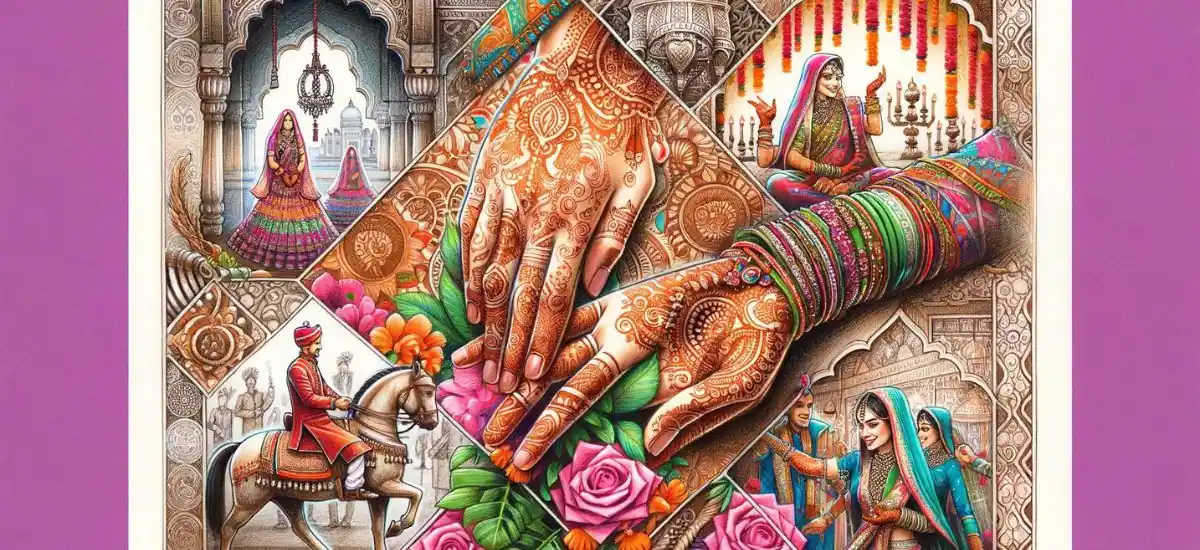
Advertisement
Crafting the perfect Indian wedding itinerary involves a deep appreciation of timeless traditions blended with personalized touches. From the vibrant Mehndi ceremony to the joyous Sangeet and the sacred wedding rituals, each day is meticulously planned to celebrate love and community.
Emphasizing flexibility and guest comfort, the itinerary integrates buffer times and ensures smooth logistics, enhancing the overall experience. Attention to detail, like providing Welcome Kits and setting up Information Desks, ensures every guest feels cherished.
By anticipating potential issues and preparing solutions, your Indian wedding unfolds as a seamless cascade of joyous events, making every moment unforgettable. This approach not only honors cultural heritage but also personalizes the celebration, making it uniquely yours.
Indian Wedding Traditions
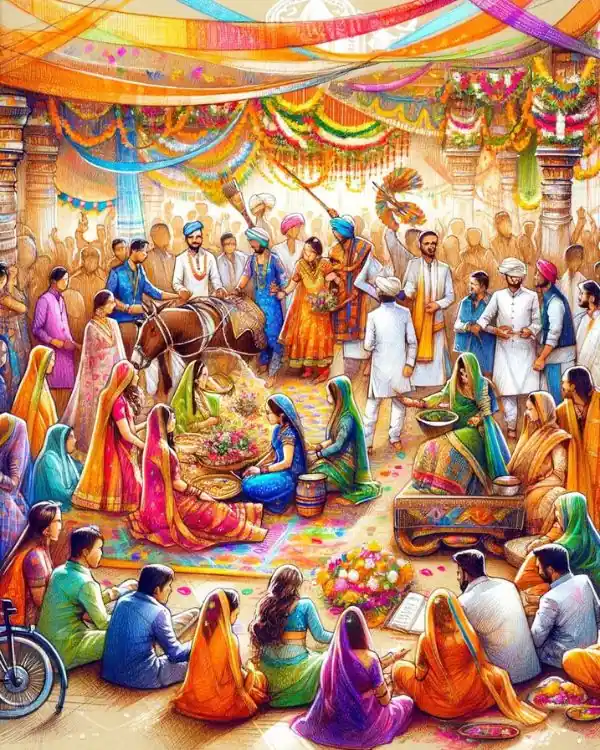
Indian weddings are a splendid affair, marked by colorful ceremonies and profound rituals that date back thousands of years. Key events like the Mehndi, Sangeet, Haldi, Baraat, and Vidaai are not just fun; they are steeped in deep cultural significance. Understanding these traditions is the first step toward honoring the past while celebrating your future.
Pre-Wedding Preparations
Setting the Date is crucial. Opt for a date with cultural or astrological importance 🌌, ensuring it aligns with the seasons for perfect weather. Assembling the Team is about choosing vendors who aren't just professionals but who understand the essence of Indian weddings, from vibrant photographers to creative caterers.
Crafting Your Wedding Itinerary
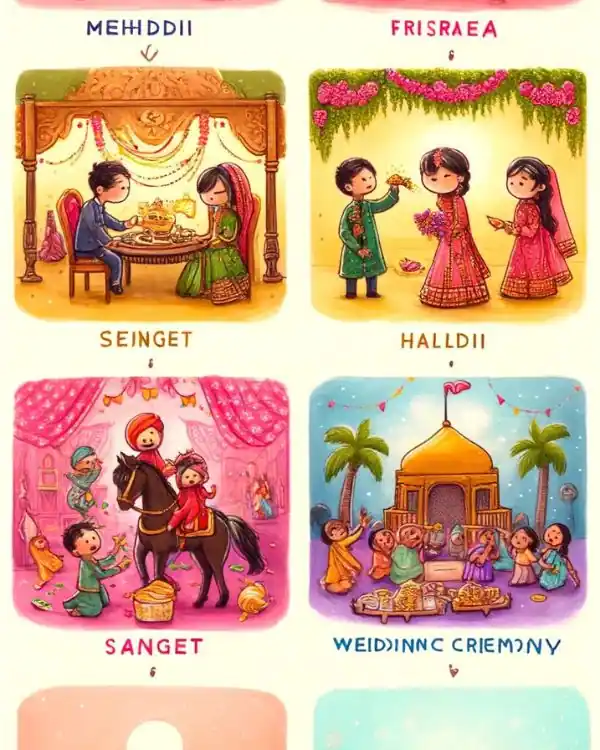
Day-by-Day Breakdown:
- Day 1: Mehndi Ceremony
Begin your wedding festivities with the enchanting Mehndi ceremony. This day is all about beauty and bonding, filled with the art of intricate henna designs that adorn the hands and feet of the bride and her guests. Set aside plenty of time for these delicate patterns to be painted—this is not just about adorning oneself, but also about the laughter and stories shared. Accompany the henna session with light music and dance, turning this into a truly memorable kickoff for the coming days.
- Day 2: Sangeet and Haldi
The vibrancy of an Indian wedding peaks at the Sangeet and Haldi. The Sangeet evening is a musical extravaganza where both families perform dances and songs, celebrating the union of the couple. Follow this with the Haldi ceremony the next morning, where turmeric paste is playfully applied to the bride and groom, believed to bless them with good luck and glowing skin. Choose a venue that reflects these vibrant traditions—think bright colors and festive decor to set the perfect mood for joy and merriment.
- Day 3: Wedding Ceremony
The wedding day is the crescendo of your celebrations. It begins with the Baraat, where the groom, mounted on a horse and accompanied by dancing guests, makes his grand entrance. This leads into the main wedding rituals, which are profound and sacred. These rituals are the core of your wedding day, symbolizing the solemn vows you exchange. It’s essential to respect and incorporate local customs and family traditions here, enriching your ceremony with the depth of your shared cultures.
- Day 4: Reception and Vidaai
Cap off the festivities with a grand reception. Plan for an evening that smoothly transitions from heartfelt toasts and speeches to a lively night of dancing and celebration. The reception is your opportunity to relax and revel with your guests, enjoying the culmination of your wedding events. The night ends with the Vidaai, an emotional farewell to the bride by her family, symbolizing her beginning a new life with her spouse. Ensure this moment is handled with care and sentiment, providing a gentle closure to the celebrations.
Each day of your wedding itinerary should reflect the beauty and uniqueness of Indian traditions, blended seamlessly with personal touches that make your wedding truly your own.
Designing the Wedding Itinerary
Designing the perfect wedding itinerary is akin to painting a masterpiece, where each brushstroke contributes to the overall beauty of the celebration.
A well-crafted itinerary not only helps manage time efficiently but also enhances the enjoyment of each ceremony by ensuring a harmonious flow. Here’s how to design an itinerary that captures the essence of your dream Indian wedding.
Start with a Draft: Begin by outlining the major events—Mehndi, Sangeet, Haldi, Wedding Ceremony, and Reception. Allocate a tentative time for each based on their traditional importance and the level of engagement they require.
Consult with Professionals: Engage with your wedding planner and other vendors to refine your draft. Their experience can provide valuable insights into how much time each event might realistically take, including setup and transitions.
Incorporate Breaks and Leisure Time: Remember to include downtime. Indian weddings can be exhilarating but exhausting. Allowing time for breaks will enable guests to rest, refresh, and socialize without feeling rushed.
Customize with Personal Touches: Add elements that reflect your personality or family traditions. Whether it's a special performance, a unique ritual, or a custom greeting, these personal touches will make your itinerary stand out.
Visual Presentation: Once your itinerary is finalized, consider creating a visually appealing version, perhaps in the form of a beautifully designed handout or a digital copy that can be accessed easily from smartphones. This can include artistic elements, icons, and a color scheme that matches your wedding theme.
Feedback Loop: Before finalizing, share your proposed itinerary with close family and friends to get their feedback. A fresh set of eyes can offer new perspectives or catch potential timing conflicts.
Communicate Clearly: Ensure that every involved party, from guests to vendors, has a copy of the itinerary well in advance. Clear communication prevents confusion and helps your wedding day proceed smoothly.
By meticulously designing your wedding itinerary, you ensure that each event seamlessly transitions into the next, creating a rhythmic flow that captivates and delights all who are part of your special day.
Logistics Management
Efficient logistics management is essential to ensure a seamless flow throughout your wedding celebrations. Proper planning of the Venue, Transportation, and Accommodation will set the stage for a flawless event.
Venue Considerations: Choose venues that resonate with the spirit of each ceremony and cater to the practical needs of your guests. Look for spaces that blend beauty with functionality, offering both aesthetic appeal and essential amenities like adequate seating and facilities. Each venue should seamlessly accommodate the unique requirements of your wedding's various events.
Transportation Logistics: Smooth transportation is key to keeping your wedding day stress-free. Arrange dedicated shuttles to transport guests between venues, ensuring everyone arrives comfortably and on time. This thoughtful arrangement eliminates navigation woes and parking hassles, making the journey as pleasant as the destination.
Accommodation Arrangements: Provide a comfortable stay for your guests, especially those coming from out of town. Opt for accommodations near the wedding venues to foster convenience and camaraderie among guests. Ensure there are options for different budgets, making everyone feel valued and taken care of.
By honing in on these aspects, you'll ensure that every transition within your wedding is smooth, allowing you and your guests to focus on the joy and celebration of your special day.
Tips for Time Management
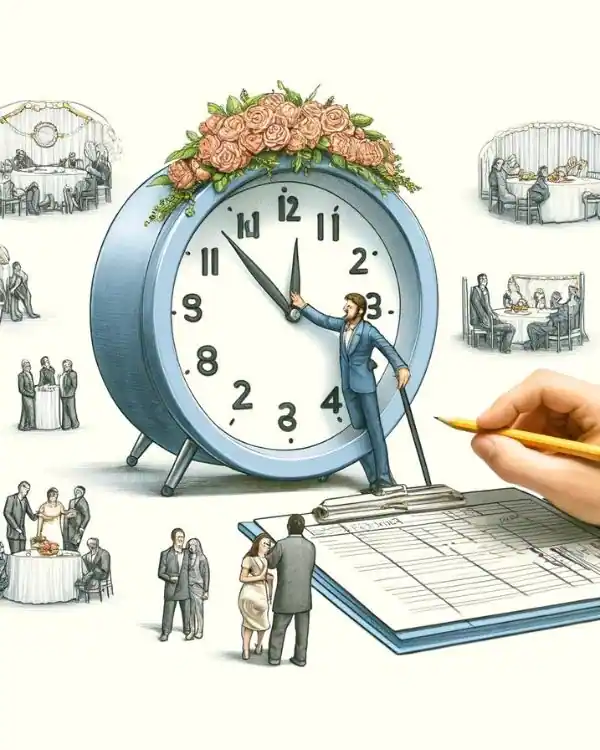
Mastering time management is crucial for ensuring that your Indian wedding unfolds as smoothly as possible. Recognizing the lively and sometimes unpredictable nature of such celebrations, it's wise to integrate Buffer Times into your wedding itinerary.
Plan for the Unexpected: Indian weddings are beautiful tapestries woven with spontaneous moments that, while delightful, can lead to delays. Whether it's a longer-than-expected toast or a traffic snag, adding buffer times between events allows these moments to unfold naturally without disrupting the day's flow.
Flexibility is Key: By scheduling these extra pockets of time, you provide a cushion that can absorb any unforeseen hiccups. This flexibility ensures that neither you nor your guests feel rushed, enhancing the overall enjoyment of each event. It transforms potential stress into moments of relaxation and socialization.
Incorporating buffer times not only helps manage the day more effectively but also brings peace of mind. Knowing there is wiggle room built into your schedule allows everyone involved to relax and truly engage in the celebration, making your wedding a joyous and memorable event for all.
Enhancing Guest Experience
Creating a memorable guest experience is pivotal in making your Indian wedding a standout event. Focus on delightful details like Welcome Kits and Information Desks to ensure every guest feels cherished and well-informed throughout the festivities.
Welcome Kits: Greet your guests with thoughtfully curated Welcome Kits as they arrive. These kits can include items like custom scarves adorned with traditional patterns, small snacks to refresh them after their journey, and perhaps a mini itinerary or a guide to the wedding events. Such personalized touches not only make guests feel valued but also heighten their excitement for the upcoming celebrations.
Information Desks: Set up Information Desks at each venue to act as a go-to resource for your guests. Staff these desks with friendly faces ready to answer any questions—from details about the day’s schedule to directions, or information about local attractions. These desks ensure guests feel supported and connected, no matter where they are in the celebration’s timeline.
By investing in these thoughtful enhancements, you transform your wedding from a mere sequence of events into a warm, inclusive celebration that guests will remember fondly for years to come.
Troubleshooting Common Issues

Weddings are complex events where many things can go unexpectedly. Preparing for these scenarios with a solid backup plan and a composed approach is crucial. Here’s a list of common issues that might arise during an Indian wedding, along with effective solutions:
Sudden Weather Changes:
- Issue: Unexpected rain or storm.
- Solution: Always have a backup indoor venue ready or tents that can be quickly set up. Ensure that your venue is equipped to handle quick shifts to indoor spaces if needed.
Vendor No-Shows or Delays:
- Issue: Key vendors like caterers, DJs, or photographers are late or don't show.
- Solution: Have a list of backup vendors who can be called at the last minute. Also, establish clear communication channels and confirmations days before the event.
Power Outages:
- Issue: Loss of power at the venue.
- Solution: Ensure your venue has a reliable generator as a backup. Test the generator before the wedding day to confirm it covers all essential electrical needs.
Medical Emergencies:
- Issue: Guests might experience health issues during the event.
- Solution: Have a basic first aid kit on hand and the contact information for the nearest hospital. Consider hiring a professional medical team if your budget allows, especially if you have elderly guests or a large guest list.
Transportation Issues:
- Issue: Problems with the arranged transportation for guests.
- Solution: Confirm all transportation details a few days before the event. Have a local taxi service on speed dial for emergencies, or arrange for a few spare vehicles to be available.
Audio-Visual Equipment Failure:
- Issue: Malfunctions with microphones, speakers, or visual displays.
- Solution: Always test all AV equipment before the event. Have an AV technician on-site during the wedding to manage any technical difficulties swiftly.
Seating Confusions or Disputes:
- Issue: Guests are unsure where to sit or disputes arise over seating arrangements.
- Solution: Ensure there are clear, visible seating charts and place cards. Have extra seating available in case of unexpected guests.
Food and Dietary Concerns:
- Issue: Insufficient food or guests with unmet dietary restrictions.
- Solution: Confirm the headcount and dietary restrictions with your caterer multiple times before the event. Always prepare extra food to accommodate additional guests or errors in headcount estimates.
By anticipating these issues and having proactive solutions ready, you can ensure that your wedding remains a joyful celebration, even when faced with the unexpected.
Frequently Asked Questions
Can I incorporate non-traditional elements into my Indian wedding itinerary? Yes, blending non-traditional elements with classic rituals can personalize your wedding and make it more meaningful. Consider including themes or activities that reflect your interests or hobbies as a couple.
How far in advance should I start planning my Indian wedding itinerary? It's advisable to start planning your wedding itinerary at least 6-12 months in advance. This gives you ample time to book venues, hire vendors, and make necessary arrangements, especially for elaborate multi-day celebrations.
What is the best way to communicate the itinerary to my guests? Providing a detailed itinerary through digital platforms such as a wedding website or a mobile app is effective. Additionally, printed itineraries can be included in welcome kits for a personal touch.
How do I handle last-minute changes to the itinerary? Stay communicative and flexible. Inform key family members and vendors about any changes immediately, and if possible, update your digital platforms or apps where guests can check for real-time updates.
Advertisement
I'm Looking For!
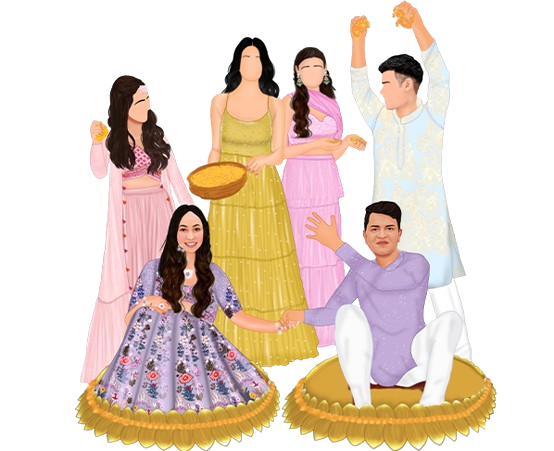



.png)
.png)
.png)

